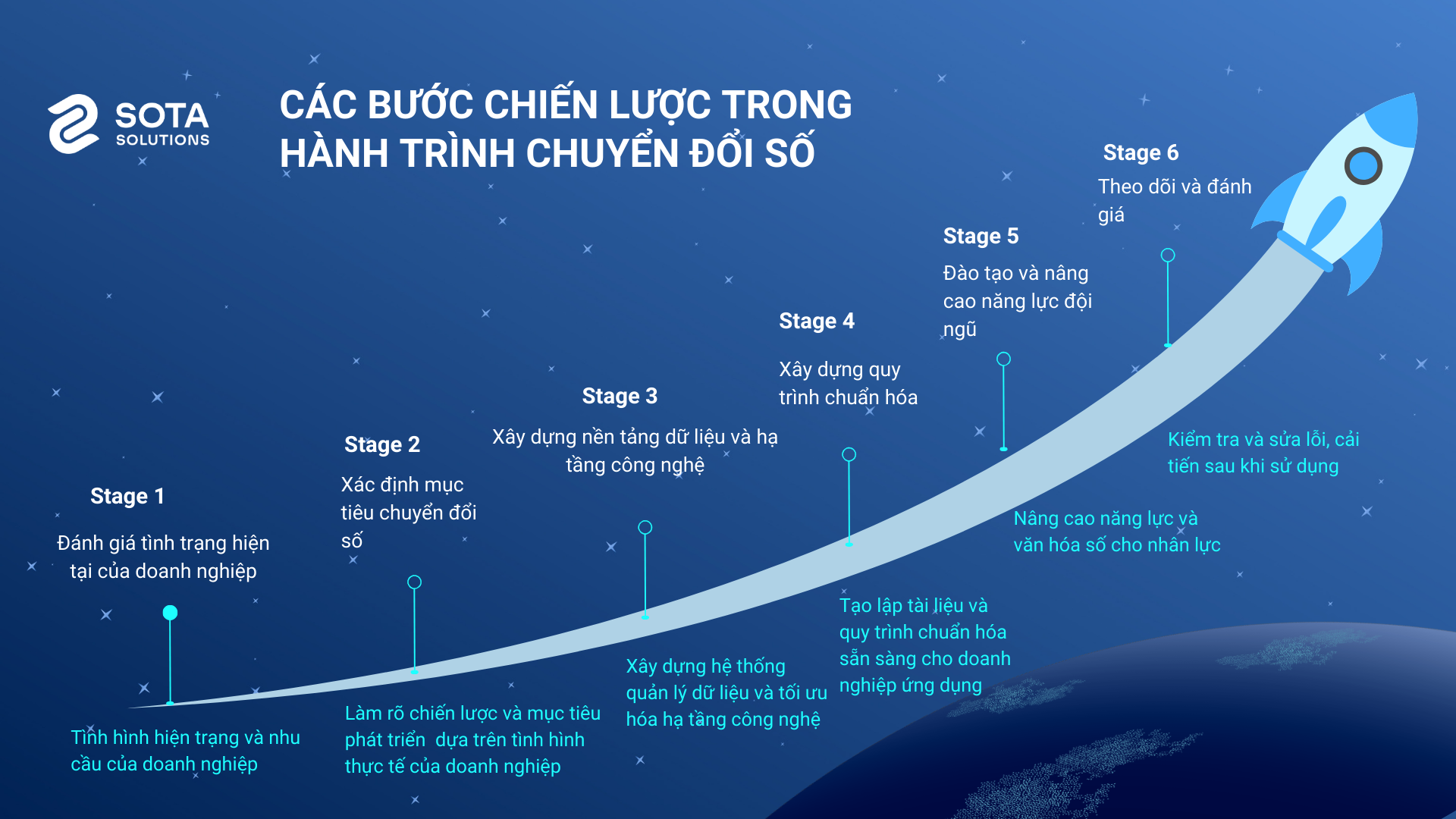In this era of rapid technological advancement, transitioning to a digital enterprise is not just a trend but also a decisive factor for maintaining competitiveness and sustainable development. However, the journey to building an effective digital enterprise is not a simple task. It requires significant investment in technology, changes in organizational culture, and optimization of work processes. In this article, we will explore the important steps to build a digital business, helping the company not only survive but also thrive in today's digital business environment.
1. What is digital transformation?

Digital Transformation is the process of integrating digital technology into all areas of a business, including workflows, organizational culture, business models, and customer communication methods. This is a process where technology not only supports current activities but also drives comprehensive changes in the way businesses operate and develop.
Digital transformation is not just about using new technology; it is a revolution in how businesses operate, from implementing management software (such as ERP, CRM), artificial intelligence (AI), big data to building a digital platform to interact with and serve customers.
2. The importance of digital transformation in the current context

Enhance efficiency and optimize the process
Digital transformation helps businesses automate workflows, thereby reducing operational costs, optimizing resources, and enhancing work efficiency. Intelligent management systems can automatically handle tasks, helping businesses save time and effort.
Enhancing customer experience
With the development of technologies such as AI, big data, and data analytics, businesses can better understand customer needs and behaviors. This helps improve customer service, provide customized and personalized products and services, thereby enhancing customer satisfaction and loyalty.
Increase competitiveness
Digital transformation helps businesses not only maintain but also enhance their competitiveness in an increasingly fierce business environment. Companies that adopt advanced technology can respond more quickly to market changes, create new products and services, and enhance customer value.
Strategic orientation and smart decision-making
Digital transformation brings the ability to collect and analyze big data, helping managers make more accurate decisions. Real-time data helps businesses grasp market trends and demands, allowing them to adjust strategies quickly and effectively.
Sustainable development
In the current context, as environmental and social issues are increasingly being prioritized, digital transformation helps businesses save resources, reduce waste, and lower energy consumption. Technologies such as cloud computing, AI, and blockchain help optimize processes and minimize negative environmental impacts.
Support for innovation
Digital transformation does not only stop at improving current processes but also creates opportunities for businesses to develop new business models. The application of technology helps create innovative products and services, thereby expanding the market and increasing revenue.
3. Strategic steps in the digital transformation journey

Evaluate the current status of the business
- Review and analyze the current workflows to identify weaknesses that need improvement, inefficient or bottlenecked steps.
- Evaluate current technology: Examine the software and technology systems that the business is using (ERP, CRM, accounting software, etc.) to assess their suitability and compatibility with digital transformation requirements.
- Evaluate the competence and readiness of the staff team.
Identify the digital transformation goals
- Identify the main goals that the business aims to achieve through digital transformation, such as reducing costs, increasing productivity, improving customer service, or growing revenue.
- Choose specific success metrics such as reducing process time, improving customer satisfaction rates, or lowering production costs.
- Ensure that the set goals are achievable within the actual context of the business.
Building data platforms and technology infrastructure
- Install and deploy data storage and analysis systems
- Investing in IT infrastructure technologies: Improving and deploying technology infrastructure, including networks, management software, security, hardware, and new digital technologies such as ERP, cloud computing, AI, IoT.
- Design and divide the stages of applying the above technologies effectively.
Building a standardization process
- Design process documentation, ensuring the application of technology.
- Standardize the operating system
Training and enhancing the capacity of the team
- Provide courses, internal training, or hire experts to train employees on new technologies such as AI, big data, cloud computing, network security, etc.
- Create an environment that encourages creativity and innovation, propose solutions to improve workflows, and experiment with new technologies.
- Build an open working environment that encourages change, creativity, and learning about digital technology.
Monitor and evaluate
- Use tools and software to monitor the implementation process of digital transformation plans and evaluate the effectiveness of each stage.
- Regularly evaluate the results achieved against the initial goals (through KPIs), and adjust the strategy as necessary to improve effectiveness or address emerging issues.
- Collect feedback from departments within the company as well as customers to better understand the effectiveness of the deployed technologies and continuously improve.
4. The challenges in the digital transformation process

High initial investment cost
Investing in new technologies such as ERP software, CRM, data analysis tools, or artificial intelligence requires a significant amount of money. For small and medium-sized enterprises, this cost can be a barrier to implementing digital transformation. In addition to technology costs, businesses also need to invest in employee training and the implementation of new systems. This process requires significant time and resources, which may make some businesses hesitant.
Issues related to security and data protection
When applying digital technology, especially cloud platforms, businesses must face risks related to data security. The compromise or leakage of important data can cause severe damage to the reputation and finances of the business. With the enormous amount of data generated during the digital transformation process, protecting, managing, and analyzing data effectively and securely is a significant challenge. Businesses need to implement advanced security measures, such as data encryption, access control, and multi-factor authentication.
Difficulty in selecting and integrating technology
On the market today, there are many different technologies and software, and choosing the right technology that meets the actual needs of the business is not always easy. Mistakes in choosing technology can lead to wasted costs and time, or even disrupt work. Integrating old technology systems with new technologies is a major challenge. The software and systems need to operate seamlessly with each other to avoid data fragmentation or workflow disruptions.
Lack of digital skills and competencies among the workforce
One of the biggest barriers to digital transformation is the lack of technological skills among the workforce. To fully leverage new technologies, businesses need a workforce skilled in using digital technology, from software to data analysis. Businesses need experts or a digital transformation consulting team to implement and oversee this process. The absence of experts can make it difficult for businesses to determine the right direction and implement an effective digital transformation strategy.
The risk of rapid technological change
Technology changes and develops at a very fast pace, and businesses may find it difficult to keep up with continuous updates. Investing in a certain technology that becomes outdated after a while can cause financial and strategic damage to the business. Businesses may struggle to predict and prepare for future technological changes. New technologies are constantly emerging, and if businesses are not prepared for these changes, they may fall behind.
5. Prominent technology trends in digital transformation
In the process of digital transformation, several prominent technology trends are contributing to changing the way businesses operate and develop. These trends include:
- Artificial Intelligence (AI) and Machine Learning - Enhancing data analysis capabilities, predicting trends, and optimizing business decisions.
- Cloud Computing - Provides flexible and cost-effective infrastructure, helping businesses easily scale and work remotely.
- Internet of Things (IoT) - Connecting smart devices and sensors, helping to monitor and optimize production and operation processes.
- Blockchain - Ensures safety and transparency in transactions, especially in industries such as finance and supply chain.
- RPA (Robotic Process Automation) - Automate repetitive processes, save time, and enhance work efficiency.
- ERP, effective enterprise management - integrating departments on the same system, saving time and manpower, reducing manual tasks, and optimizing business efficiency.
In the future, these technology trends will help businesses grow rapidly and sustainably, enhance competitiveness, reduce operational costs, and provide personalized customer experiences. The effective integration of these technologies will create flexible, innovative businesses that are highly adaptable to the rapid changes in the market.
6. Conclusion
Digital transformation is not only about adopting new technologies but also about changing mindsets and business strategies to align with market trends and demands. A successful digital enterprise will not only optimize operational efficiency but also create sustainable value for customers and stakeholders. By applying the right strategic steps and continuously improving, businesses can build a solid foundation. Contact us for consultation and to receive free materials.